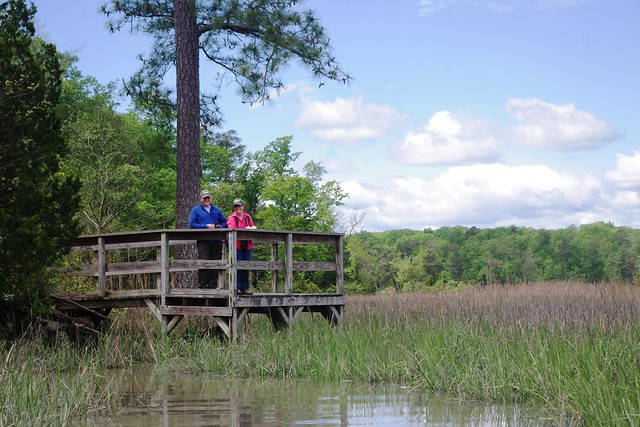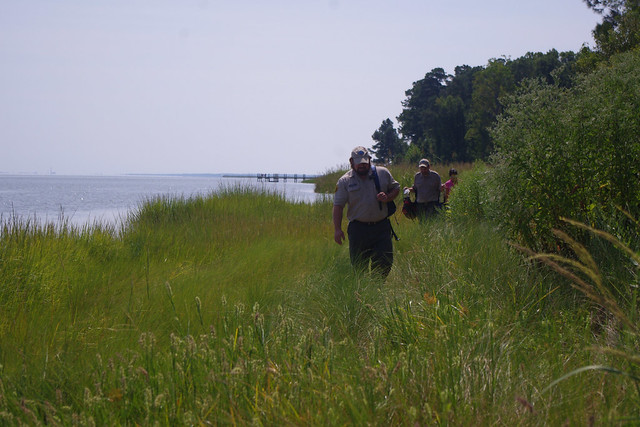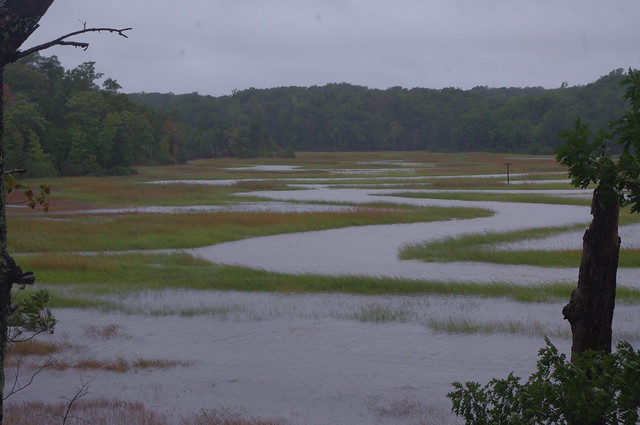Read Our Blogs
Meet the Marsh: Definition & Types
Published Aug. 8, 2020 | Updated July 16, 2021
One of the best things about a visit to York River State Park is encountering the marshes. Part one of this series: Definition and types of marsh.
Along Taskinas Creek, the river, and a few unnamed streams, one can appreciate the unique plant life and observe the creatures that live in these vital wetlands.
Marshes are great places to explore.
Not a Swamp
Sometimes this type of wetland is called a “swamp.” The difference between them is just above your head. A swamp has a closed canopy of tree branches blocking sunlight from reaching the ground. There is no canopy, sometimes referred to as an open canopy, above the ground in a marsh.
In Virginia, most swamps are freshwater. The upper reaches of Taskinas Creek have a freshwater marsh where the trees inside the wetland are not tall enough to form a canopy. This marsh is accessible only by boat with a small overlook on the Meh-Te-Kos Challenge Loop Equestrian Trail. However, all other guests can visit at least one of our brackish, called estuarine, marshes.
A view of the Taskinas Creek Marsh.
Expansive Experience
An expansive marsh is a wetland that surrounds a small body of water. The Taskinas Creek Valley is a perfect example of this, with some of the best views at picnic shelter #1, the Taskinas Creek observation deck, and the gazebo.
We rent canoes and kayaks, and guests are free to visit the dock for an up-close and personal look inside of the marsh. Hikers along the Taskinas Creek Trail can stop at five different platforms to get a better look into the wetland.
Wetland along the river.
Following the Fringes
A fringe marsh is a wetland that lies on the edge of a large body of water. They can be found beside the Fossil and Seining Beaches along the York River. Plus, marshes surround the unnamed streams crossing the Mattaponi Trail and the footbridge between the Majestic Oak and Powhatan North Fork Trails.
Horseback riders and mountain bikers are also welcome to visit the Riverview Beach area.
Marshes absorb excess water during storm surges.
Super Sponge
Marshes play a significant role in keeping the Chesapeake Bay and its tributary rivers healthy. The wetlands help to remove excess soil run-off and nutrients. They also absorb water from storm surges and protect the higher ground from erosion.
Hurricane Isabelle struck Virginia in 2003. High floodwaters damaged many waterfront homes. Homes built near marshes were not as affected, as the wetlands acted like sponges, taking in the tides and rainfall. By leaving marshes intact, we promote the health of the bay and the value of already developed land.
York River State Park is located near Williamsburg, Virginia. For more information, please visit our website. For a Google map, please click here.
This is the first in a series of articles on the marshes at York River State Park. The second installment is Meet the Marsh: Grass & Sky and the third is Meet the Marsh: Creatures and Critters.
If you have read the article and have a question, please email nancy.heltman@dcr.virginia.gov.


















